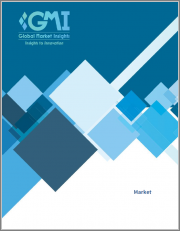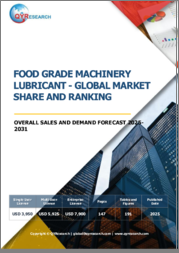
|
시장보고서
상품코드
1388311
식품용 윤활유 시장 규모 : 기유 유형, 등급, 용도별, 세계 예측(2023-2032년)Food Grade Lubricants Market Size - By Base Oil Type, Grade, Application & Global Forecast, 2023 - 2032 |
||||||
세계의 식품용 윤활유 시장은 지속가능·친환경 윤활 솔루션이 중시됨에 따라 2023-2032년 CAGR 7.3%로 성장합니다.
산업계가 환경적 책임을 우선시함에 따라 환경 친화적 노력에 부합하는 윤활유에 대한 수요가 증가하고 있습니다. 엄격한 규제와 생태계에 미치는 영향에 대한 인식이 높아짐에 따라 시장 성장이 촉진되고 있으며, 기업은 지속가능한 관행을 도입하는 것이 중요하다는 것을 인식하고 있습니다. 친환경 윤활 솔루션으로의 전환은 환경 발자국을 줄이고 보다 지속가능한 미래에 기여하고자 하는 산업 환경의 진화를 반영합니다.
예를 들어 네스테는 2023년에 재생하거나 재 정제된 기유와 고품질 첨가제로 만든 혁신적이고 친환경적인 윤활유를 출시할 계획을 발표했습니다. 이 지속가능한 솔루션을 통해 Neste의 고객은 원유 기반 제품에 대한 의존도를 줄일 수 있으며, 윤활유 분야에서도 지속가능한 미래를 향한 큰 진전을 이룰 수 있습니다.
식품용 윤활유 시장은 기유 유형, 용도 및 지역에 따라 두 가지로 나뉩니다.
바이오 오일 분야는 지속가능하고 친환경적인 윤활 솔루션에 대한 관심이 높아짐에 따라 2032년까지 괄목할 만한 성장을 이룰 것으로 예상됩니다. 재생한 자원에서 추출한 바이오 오일은 식품 및 음료 산업에서 친환경 대체품에 대한 수요 증가와 일치합니다. 식품 안전에 대한 규제 감시가 강화됨에 따라 보다 안전하고 규정을 준수하는 윤활유 대안으로 바이오 오일의 채택이 증가함에 따라 시장에서의 입지가 강화될 것으로 보입니다.
음료 및 식품 제조 부문의 식품용 윤활유 산업 규모는 2032년까지 큰 이익을 얻을 것입니다. 음료에 대한 세계 수요 증가와 위생 및 안전 표준에 대한 관심이 높아짐에 따라 음료 생산 공정에서 신뢰할 수 있는 윤활 솔루션에 대한 필요성이 증가하고 있습니다. 식품 안전에 대한 엄격한 규제가 계속해서 산업을 형성함에 따라 음료 및 식품 제조 용도를 위해 설계된 윤활유는 규정 준수 및 운영 효율성을 보장하는 데 매우 중요한 역할을 강조하며 큰 시장 점유율을 차지할 것으로 보입니다.
아시아태평양 식품용 윤활유 시장은 2023-2032년 급성장하는 식품 및 음료 산업과 식품 안전 및 위생에 대한 관심 증가에 힘입어 주목할 만한 시장 점유율을 기록할 것으로 예상됩니다. 제조 표준이 발전하고 엄격한 규제가 시행됨에 따라 고품질 식품용 윤활유에 대한 수요가 증가하고 있습니다. 아시아태평양의 견고한 경제 성장, 산업 활동의 확대, 식품 제조 공정 강화에 대한 노력은 아시아태평양이 시장 점유율을 높이는 데 중요한 기여를 할 것으로 보입니다.
목차
제1장 조사 방법과 조사 범위
제2장 주요 요약
제3장 식품용 윤활유 업계 인사이트
- 에코시스템 분석
- 업계에 대한 영향요인
- 촉진요인
- 업계의 잠재적 리스크 & 과제
- 성장의 가능성 분석
- COVID-19 영향 분석
- 규제 상황
- 미국
- 유럽
- 가격 분석, 2022년
- 기술 전망
- 향후 시장 동향
- Porter의 산업 분석
- PESTEL 분석
- 러시아·우크라이나 전쟁이 업계에 미치는 영향
제4장 경쟁 구도
- 서론
- 기업 매트릭스 분석
- 세계 기업 점유율 분석
- 경쟁 포지셔닝 매트릭스
- 전략 대시보드
제5장 식품용 윤활유 시장 규모·예측 : 기유 유형별 2018-2032년
- 광유
- 합성유
- 바이오 기반 오일
제6장 식품용 윤활유 시장 규모·예측 : 등급별 2018-2032년
- H1
- H2
- H3
제7장 식품용 윤활유 시장 규모·예측 : 용도별 2018-2032년
- 식품 가공
- 음료 제조
- 의약품 제조
- 육류, 가금육, 어개류
- 기타
제8장 식품용 윤활유 시장 규모·예측 : 지역별 2018-2032년
- 주요 동향 : 지역별
- 북미
- 미국
- 캐나다
- 유럽
- 독일
- 영국
- 프랑스
- 스페인
- 이탈리아
- 아시아태평양
- 일본
- 중국
- 인도
- 호주
- 한국
- 인도네시아
- 말레이시아
- 라틴아메리카
- 브라질
- 멕시코
- 아르헨티나
- 중동 및 아프리카
- 남아프리카공화국
- 사우디아라비아
- 아랍에미리트
- 이집트
제9장 기업 개요
- Exxon Mobil Corporation
- Fuchs Petrolub SE
- Klüber Lubrication
- TotalEnergies
- BP PLC
- Chevron
- Petro-Canada Lubricants Inc.
- Ashland Global Holdings
- Dow Chemical Company
- JAX Inc.
- SKF
- Illinois Tool Works Inc
- Elba Lubrication Inc
- CRC Industries
- Nye Lubricants
Global Food Grade Lubricants Market will grow at a CAGR of 7.3% from 2023 to 2032, driven by a growing emphasis on sustainable and eco-friendly lubrication solutions. As industries prioritize environmental responsibility, the demand for lubricants that align with green initiatives rises. Stringent regulations and a heightened awareness of ecological impacts will drive the market's growth, with businesses recognizing the importance of incorporating sustainable practices. This shift towards environmentally conscious lubrication solutions reflects an evolving industry landscape committed to reducing its environmental footprint and contributing to a more sustainable future.
For instance, in 2023, Neste announced plans to launch innovative, eco-friendly lubricants crafted from renewable or re-refined base oils alongside high-quality additives. This sustainable solution empowers Neste's customers to reduce reliance on crude oil-derived products, marking a significant stride towards a more sustainable future, even in the realm of lubricants.
The food grade lubricants market is bifurcated based on base oil type, application, and region.
Bio-based oil segment will attain remarkable gains through 2032, driven by the increasing emphasis on sustainable and environmentally friendly lubrication solutions. Bio-based oils, derived from renewable sources, align with the growing demand for eco-friendly alternatives in the food and beverage industry. As regulatory scrutiny on food safety intensifies, the adoption of bio-based oils as a safer and more compliant lubrication choice would propel their prominence in the market.
The food grade lubricants industry size from the beverage production segment will garner significant gains through 2032. With a growing global demand for beverages and an increased focus on hygiene and safety standards, the need for reliable lubrication solutions in beverage production processes intensifies. As stringent regulations surrounding food safety continue to shape the industry, lubricants designed for beverage production applications will acquire a significant market share, emphasizing their pivotal role in ensuring compliance and operational efficiency.
Asia-Pacific food grade lubricants market will register a noteworthy market share from 2023 to 2032, fueled by the burgeoning food and beverage industry, in covalence with the region's increasing focus on food safety and hygiene. As manufacturing standards evolve and stringent regulations are enforced, the demand for high-quality food-grade lubricants rises. The robust economic growth, expanding industrial activities, and the region's commitment to enhancing food production processes will position Asia-Pacific as a key contributor in shaping the market's significant share.
Table of Contents
Chapter 1 Methodology & Scope
- 1.1 Industry coverage
- 1.2 Market scope & definition
- 1.3 Base estimates & calculations
- 1.3.1 Data collection
- 1.4 Forecast parameters
- 1.5 COVID-19 impact analysis at global level
- 1.6 Data validation
- 1.7 Data Sources
- 1.7.1 Primary
- 1.7.2 Secondary
- 1.7.2.1 Paid sources
- 1.7.2.2 Unpaid sources
Chapter 2 Executive Summary
- 2.1 Food Grade Lubricants industry 360 degree synopsis, 2018 - 2032
- 2.2 Business trends
- 2.3 Base Oil Type trends
- 2.4 Grade trends
- 2.5 Application trends
- 2.6 Regional trends
Chapter 3 Food Grade Lubricants Industry Insights
- 3.1 Industry ecosystem analysis
- 3.2 Industry impact forces
- 3.2.1 Growth drivers
- 3.2.2 Industry pitfalls & challenges
- 3.3 Growth potential analysis
- 3.4 COVID- 19 impact analysis
- 3.5 Regulatory landscape
- 3.5.1 U.S.
- 3.5.2 Europe
- 3.6 Pricing analysis, 2022
- 3.7 Technology landscape
- 3.7.1 Future market trends
- 3.8 Porter's analysis
- 3.9 PESTEL analysis
- 3.10 Russia-Ukraine War Impact on the industry
Chapter 4 Competitive Landscape, 2022
- 4.1 Introduction
- 4.2 Company matrix analysis, 2022
- 4.3 Global company market share analysis, 2022
- 4.4 Competitive positioning matrix
- 4.5 Strategy dashboard
Chapter 5 Food Grade Lubricants Market Size and Forecast, By Base Oil Type 2018 - 2032
- 5.1 Mineral Oil
- 5.2 Synthetic Oil
- 5.3 Bio-based Oil
Chapter 6 Food Grade Lubricants Market Size and Forecast, By Grade 2018 - 2032
- 6.1 H1
- 6.2 H2
- 6.3 H3
Chapter 7 Food Grade Lubricants Market Size and Forecast, By Application 2018 - 2032
- 7.1 Food processing
- 7.2 Beverage production
- 7.3 Pharmaceutical manufacturing
- 7.4 Meat, Poultry, and Seafood
- 7.5 Other
Chapter 8 Food Grade Lubricants Market Size and Forecast, By Region 2018 - 2032
- 8.1 Key trends, by region
- 8.2 North America
- 8.2.1 U.S.
- 8.2.2 Canada
- 8.3 Europe
- 8.3.1 Germany
- 8.3.2 UK
- 8.3.3 France
- 8.3.4 Spain
- 8.3.5 Italy
- 8.4 Asia Pacific
- 8.4.1 Japan
- 8.4.2 China
- 8.4.3 India
- 8.4.4 Australia
- 8.4.5 South Korea
- 8.4.6 Indonesia
- 8.4.7 Malaysia
- 8.5 Latin America
- 8.5.1 Brazil
- 8.5.2 Mexico
- 8.5.3 Argentina
- 8.6 MEA
- 8.6.1 South Africa
- 8.6.2 Saudi Arabia
- 8.6.3 UAE
- 8.6.4 Egypt
Chapter 9 Company Profiles
- 9.1 Exxon Mobil Corporation
- 9.2 Fuchs Petrolub SE
- 9.3 Klüber Lubrication
- 9.4 TotalEnergies
- 9.5 BP PLC
- 9.6 Chevron
- 9.7 Petro-Canada Lubricants Inc.
- 9.8 Ashland Global Holdings
- 9.9 Dow Chemical Company
- 9.10 JAX Inc.
- 9.11 SKF
- 9.12 Illinois Tool Works Inc
- 9.13 Elba Lubrication Inc
- 9.14 CRC Industries
- 9.15 Nye Lubricants














